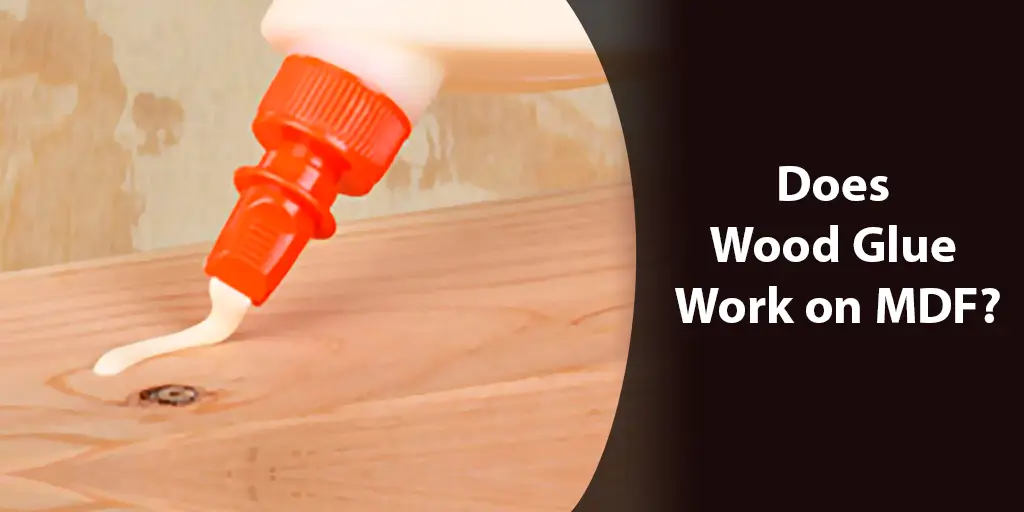Medum Density Fiberboard, commonly known as MDF, has become one of the most widely used and versatile manufactured wood materials for furniture, cabinetry, trim work and more.
However, many woodworkers still find themselves wondering – does wood glue actually work to bond pieces of MDF together into a strong and lasting finished project?

MDF offers several advantages that have made it a popular choice for craftspeople and DIYers alike.
As a manufactured board created by bonding wood fibers together under heat and pressure, MDF provides a consistent, uniform material at a very affordable price point.
It machines and finishes nicely, accepting paints, stains or varnishes well. Its lightweight yet stable nature also makes it easier to work with than some natural wood species.
But precisely because MDF is manufactured rather than growing naturally, there are some differences compared to solid wood boards that can leave glue joints in question.
The wood fibers in MDF are pressed so tightly that the board itself may seem almost plastic-like. And without the natural origins of wood, does glue truly “bite” into MDF boards the way it does with traditional wood?
This is an important consideration for any woodworker hoping to assemble larger MDF projects with strong, lasting joins.
With furniture and cabinets experiencing stresses and impacts through daily use, the bond between panels really needs to last.
In this article, we’ll investigate whether wood glues can indeed succeed at permanently bonding MDF.
We’ll examine the suitability of common adhesive types, offer techniques for clean and effective application, and provide recommendations from experienced makers on best practices when working with this engineered wood material.
MDF vs Other Woods
To fully understand whether wood glues can effectively bond MDF, it’s instructive to first explore the material composition and properties that set it apart from natural wood boards.
MDF is created through an industrial process of refining wood chips into fiber particles. These fibers are combined with wax and resin adhesives then pressed together and dried under intense heat.
This forms dense, homogeneous boards devoid of the natural grains and textures found in wood.
The end result is a substrate that behaves quite differently than conventional lumber. For one, MDF has a more consistent density throughout.
With natural wood, layers may vary in hardness or contain knots, cracks or pores – all of which influence its bonding tendencies. MDF presents a uniform surface at the same thickness from edge to edge.
Its man-made manufacturing also yields key performance distinctions. At around 45 to 50 pounds per cubic foot, MDF is significantly lighter than most wood types of equal dimensions. This makes it easier for homeowners and artisans to lift, cut and install.
However, there is a tradeoff in strength. Without natural cellulose fibers running the length of the board, MDF lacks the highest levels of durability and impact resistance found in some species like oak or maple. It dents and dings more easily from concentrated pressures.
Its fiber-and-resin composite structure also creates a less porous material than solid wood. Some glues work partially by seeping into microscopic voids between wood grain cells.
With MDF’s dense, non-porous composition, adhesives must find purchase chemically bonding to the material itself.
Do these material differences influence how well wood glues can adhere MDF? Read on to discover testing and expertise on optimal gluing solutions for this engineered substitute to traditional lumber.
Does Wood Glue Work on MDF?
Now that we understand the compositional variances between MDF and natural wood, the burning question remains – can wood glues effectively bond this man-made board material?
Interestingly, despite its non-porous, pressed structure, most woodworking experts and seasoned DIYers agree – yes, wood glues can genuinely work well for joining MDF panels when using the right varieties and application techniques.
To test widely held assumptions, manufacturers and independent labs have conducted rigorous experiments gluing together MDF samples with various adhesive types.
They found that top-selling brands like Titebond, Gorilla Glue and Elmer’s did securely fasten fabrication scraps after full curing.
The molecular actions able to form durable bonds are less reliant on wood’s cellulose than the chemistries within modern glues.
PVA and epoxy formulations have evolved complex resin mixtures that fuse well to even tightly-compressed fibers like those comprising MDF.
real-world projects further confirm wood glues’ functionality. Countless finished furniture pieces, cabinets, molding installations and more have endured extensive use and abuse without delaminating at joints. This speaks volumes to the adhesive strengths achievable.
Of course, the type of glue and handling methods can impact outcomes. But in knowledgeable hands and with proper cleaning/drying procedures, woodworking adhesives are definitely capable of permanently meshing MDF components into one cohesive unit.
No longer does the material’s synthetic origins have to dictate uncertainty. By selecting highly-rated glues and implementing careful application techniques, MDF projects can now be assembled with peace of mind in their strength and longevity.
Best Types of Wood Glue for MDF
With the question of “does wood glue work on MDF?” now answered in the affirmative, the focus turns to selecting the optimal adhesive varieties for this purpose.
While many glues will form a bond, some stand above others in attributes like bonding effectiveness, durability, ease of use and safety. Here are three top-recommended options:
PVA Wood Glue
By far the most ubiquitous and inexpensive type, polyvinyl acetate (PVA) glue reigns supreme due its performance across a wide range of projects.
This family of glues, which includes famous brands like Titebond, Elmer’s and Scotch, offer decent holding power fast drying capabilities. They clean up readily with water and sander dust.
For general DIY use and beginners, a PVA glue strikes the ideal balance of attributes. Its affordability also means not stressing a budget on an initial MDF test run.
Epoxy Wood Glue
When long-term durability under tough conditions is paramount, epoxy arises as a premiere choice.
Consisting of two parts that chemically react during curing, epoxies form incredibly strong, waterproof bonds perfect for high-traffic furniture or outdoor applications.
They adhere impeccably to MDF’s compositionally challenging surface. Only downsides are increased cost and moderately longer curing over PVAs. For structurally critical projects, epoxy gives unmatched reassurance in the glue joint.
Plastic Resin Glue
Offering strength on par with epoxy but faster drying, plastic resin glues create rigid, solvent-proof assemblies from MDF.
Their adhesion truly exceeds any potential stresses from daily use. However, these glues contain concerningly toxic chemicals requiring respirator use – a negative tradeoff for casual DIYers.
Professionals will appreciate maximum durability where safety protocols can be followed.
Read Also: How Long Does Wet Wood Take to Dry
Recommendations for Best Wood Glue for MDF
With an understanding of the top adhesive types suited for MDF, it’s helpful to call out some specific product recommendations that woodworkers consistently achieve success with.
Here are a few top-rated options to consider:
Titebond Ultimate Wood Glue
As the gold standard PVA glue, Titebond performs remarkably well bonding MDF for most applications. It dries quickly to a very strong yet flexible bondrous.
Titebond resists breaking down over time from weather or moisture exposure common to other economy brands. At around $10, its reasonable cost makes it a safe choice for any indoor or lightly outdoor used furniture or trim project.
Gorilla Wood Glue
For heavy-duty strength on par with epoxies, Gorilla Wood Glue stands out. Independent testing shows it can bind MDF, plywood, and solid wood with formidable adhesion results.
Clean up is simple with just water. At around $8, it’s also budget-friendly for the holding power delivered.Cabinet builders and those constructing projects to last generations appreciate Gorilla’s durability.
Elmer’s Wood Glue
A classic PVA that remains a fixture in home shops worldwide. Elmer’s bonds MDF with reliability at a great introductory price point.
It comes highly recommended by woodworkers just starting out or doing occasional DIY projects. Dries clear and sands smoothly for stain or paint application over the joints. Rare to find a more affordable solution.
By choosing a top product within the optimal glue categories outlined, MDF craftspeople can feel confident in a permanent assembly with just a small tube. Test reviews prove these adhesives live up to their reputations.
How to Bond MDF Together
With the right wood glue in hand, the final piece of the puzzle is correctly applying it to join MDF boards into a strong, lasting creation. Proper surface preparation and clamping technique are important to achieve a durable bond.
Start by cleaning all contacting surfaces thoroughly. Dust, dirt, oils or any debris will prevent the adhesive from fully contacting the MDF beneath.
Carefully wipe surfaces with a clean, dry rag or use compressed air. Any grains of contamination could weaken the joint.
It’s also wise to test the glue on a sample piece first. This confirms compatibility with your MDF and gives feedback on coloration after drying. Make adjustments if needed before beginning the project in earnest.
Apply a thin, even layer of glue using a plastic putty knife or wooden clamping cauls to spread it efficiently. Too much filler will squeeze out under pressure; too little leaves gaps. Take time to fully coat the joining areas.
Press boards firmly together and brace with clamp cauls if necessary to evenly distribute pressure before the initial set. Proper clamping force encourages maximum contact between substrates at a microscopic level.
Once dried, inspect for any squeeze-out and wipe clean with a slightly dampened rag. Minimize sanding cured adhesive for a clean look.
Finally, consider small brads or screws through outer edges for added reinforcement of wider MDF panels under heavy duress.
Cured overnight, the joint will reach optimum strength. Follow these steps and your MDF project stands to hold up against years of rugged service.
FAQs
Can you use wood glue on MDF trim?
Absolutely! MDF is commonly used for interior trim and moldings thanks to its affordability and easy machining.
Wood glues form durable connections suited for trim applications seeing foot traffic or minor impacts.
Just be sure to properly clean and clamp the bonding surfaces. With a high-quality PVA or epoxy, your glue joints will stand up to daily wear and tear.
Can you use wood glue on particle board?
Yes, wood glues adhere well to particle board – another common composite material made from wood shreds.
Like MDF, particle board demands cleaning of its dense exterior to allow the adhesive full contact.
Follow directions for even application and clamping pressure to create a bond comparable to joining solid woods. The right wood glue treats these man-made boards similarly.
How do you seal MDF with wood glue?
A simple method to protect raw MDF edges and surfaces involves a wood glue sealant. Mix an ordinary PVA adhesive with a small amount of water in a ratio of 80/20 glue to water.
Applying this dilute mixture with a synthetic brush forms a clear barrier while still allowing your finish coats to properly bond later. Let dry completely before sanding or finishing over for the best adhesion.
What type of wood joint is strongest for MDF?
Using both adhesive and mechanical fasteners provides the maximum strength. Common woodworking joints like butt joints, rabbet joints, and dado joints all work well for MDF when reinforced with glue and finishing nails or brads.
Corner joints create solid right angles when the pieces are held tightly together as the bond develops. Placing screws from outside faces adds further integrity if long-term durability is key.
Final Thoughts
With the wealth of information presented here on MDF and gluing techniques, woodworkers can now confidently construct lasting projects from this affordable engineered material.
While not natural wood, medium density fiberboard still allows creativity when joined properly.
The takeaway is that yes indeed, wood glues reliably bond MDF boards when using best practices. From furniture to moldings to cabinetry, a wooden appearance can be achieved without the heavier weight or cost of solid lumber.
Paying attention to the type of glue, surface preparation, application methods and curing process results in dutch door assemblies, kitchen kickboards, and more that will withstand years under constant household use.
For those new to the medium, a basic white PVA represents the safest starting point. However, professionals or serious DIYers tackling larger-scale pieces or outdoor installations would do well choosing an epoxy or specialist plastic resin.
While more expensive initially, their sheer adhesive qualities provide long term peace of mind.
With simple adjustments to their normal techniques, woodworkers of any skill level now may confidently cut and join MDF with glue alone or supplemented by nails.
No longer should this engineered material be seen as an inferior substitute – rather, an excellent lower-cost alternative unleashing new possibilities when joined properly.
With care and the tested methods discussed here, glue makes MDF a truly wood-like option ready for whatever project inspires.



